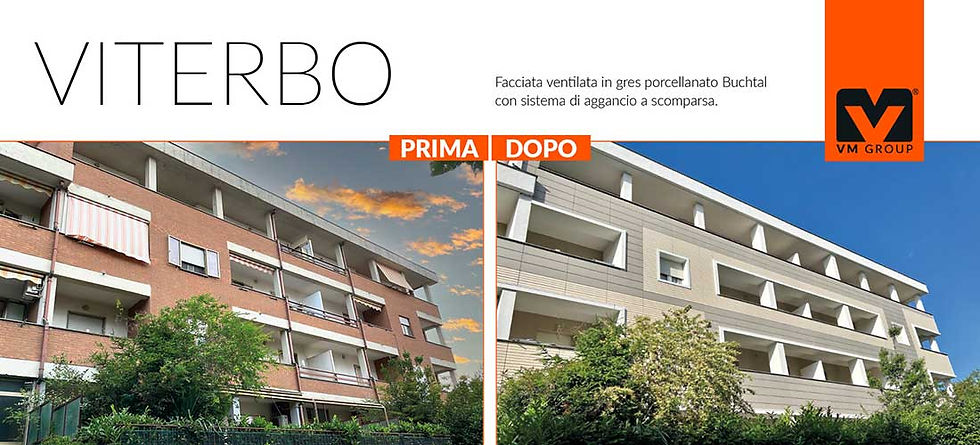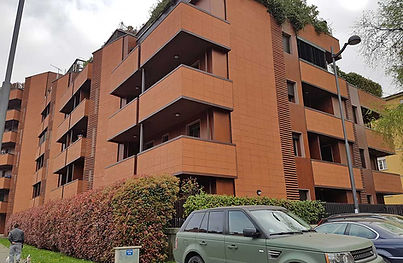
Ventilated facades
Ventilated facades offer an excellent degree
energy efficiency and acoustic comfort
An overview of the features, advantages and applications of the construction system
Ventilated facades are a complex and innovative system in the construction industry, characterized by an insulating layer fixed to the load-bearing structure and a cladding layer applied to the building using anchoring systems.
All this allows an air gap to be created between the insulating layer and the cladding layer, which, causing the so-called "CHIMNEY EFFECT", promotes effective natural ventilation, bringing numerous advantages and benefits.
Ventilated facades play a key role in buildings because they separate the interior from the exterior. This improves the thermal and acoustic comfort of interior spaces and influences the architecture of the surrounding exterior.
To create ventilated facades, the focus is on improving aesthetics and reducing energy consumption.
GREATER LIVING COMFORT
Energy savings due to lower heat dispersion from the walls;
Zero-cost maintenance;
Effective protection of the wall structure from atmospheric agents;
Greater sound insulation;
Elimination of thermal bridges;
Elimination of condensation thanks to the presence of the air cavity, which promotes the expulsion of humidity caused by infiltrations;
Excellent functionality of the external insulating layer which, thanks to good ventilation, stays dry;
Possibility of intervention on each individual slab.




VENTILATED FACADES: Systems Compared
The exterior cladding of buildings can be achieved with traditional systems such as external thermal insulation (ETICS ), in which the wall is protected by an insulating layer. These solutions, over time, deteriorate the exterior cladding and have poor wall breathability.
Another solution that can be used is the curtain wall system, in which a continuous transparent surface (usually glass) is attached to the load-bearing structure. This solution is extremely complex as it performs tasks that are traditionally performed by perimeter walls and windows.
The best solution between curtain walls and thermal insulation systems is the ventilated wall . This system allows cladding elements to be mounted using mechanical fastenings. This creates an air space between the load-bearing structure and the external facing.
VENTILATED FACADES: structure and technology
The ventilated facade is a cutting-edge building cladding system that uses mechanical anchors to secure a new skin to the exterior wall.
The anchoring system is fixed to the external walls of the building using brackets and profiles that allow the installation of an external cladding and an insulating material forming an air cavity.
Ventilated facades are therefore made up of the following functional layers:
Cladding anchoring system;
Insulating material fixed to the wall;
Ventilation air chamber;
External cladding.
COMPOSITION OF VENTILATED FACADES

facing slab
structural node
upright
insulating
Ventilated facades are made up of:
Insulating layer made of insulating material, fixed to the external wall of the building;
Aluminum substructure, anchored with brackets and designed according to the chosen cladding material;
External cladding, installed with open joints.
The insulating layer is laid on the external facade of the building, forming a continuous layer. Special materials for ventilated facade systems are used.
The aluminum substructure is designed to create an empty space between the insulation layer and the external cladding panel. Special grilles located at the base and top of the ventilated façade create a ventilation effect known as the "stack effect," caused by the different air temperatures in the ventilation chamber and the outside air.
Exposed anchoring systems
With these systems the panels that make up the external facing are supported by visible stainless steel hooks.

Retractable anchoring systems
They have a greater aesthetic value as the slabs are fixed to the substructure, hiding the anchoring.

The ability to use materials in large, unconventional formats allows for greater architectural creativity.
Design plays a fundamental role in assessing the essential aesthetic and structural requirements of a ventilated façade . It determines the modular layout, cladding materials, and the overall thickness of the façade.
The materials used for ventilated facades can be made of different materials:
natural stone
ceramic
fiber cement
metal
cooked
high pressure laminates (HPL) and composite materials.
The material chosen for the ventilated facade must have specific technical characteristics:
high color fastness to sunlight;
resistance to chemical attacks
resistance to pollutants;
remarkable mechanical resistance;
strong resistance to thermal shock;
minimal water absorption;
reduced maintenance;
fireproof;
lightness;
Ventilated facades are considered an effective thermal and acoustic insulation solution. The protective layer, previously secured to the supporting layer using a special anchoring system, is placed at a minimum distance of 3 cm from the building's internal structure. This creates an air gap that, being in contact with the outside at both the base and the top of the building, allows for natural ventilation.
The purpose of ventilated facades is to protect the internal part from water or other atmospheric agents and prevent the formation of condensation on the surface of the wall behind.
THE ADVANTAGES OF VENTILATED FACADES
Ventilated facades are the most effective external cladding technology for protecting buildings from humidity and atmospheric agents while also promoting greater othermal and acoustic insulation.
Maintenance is made easier as the external facing is made of materials with high technical and resistance characteristics.
The modularity of the substructure simplifies the possible replacement of each individual slab in the event of damage or for the possible installation or repair of underlying pipes.
Thermal protection is also fundamental, eliminating thermal bridges and increasing the building's energy performance.
The airflow created in the cavity from bottom to top allows for greater breathability of the ventilated facade and eliminates humidity.
Thanks to this natural air movement, the ventilated facade expels hot air into the ventilation chamber in summer, reducing high temperatures. It also acts as a heat shield, retaining and reflecting solar energy.
During the winter, airflow removes humidity from the interior, eliminating condensation and any water infiltration.
Insulation during the winter

The presence of the insulating layer on the outside of the wall achieves the best result in terms of phase shift and dispersion of the heat produced internally.
Weather protection

The presence of the cladding prevents rain from reaching the insulating layer, thus avoiding the accumulation of humidity on the walls of the building.
Isolation during the summer

The presence of a screen distant from the insulating layer reduces the amount of heat radiation incident on the insulation itself.
Sound insulation

The correct choice of facing increases the effectiveness of the wall in terms of transmission of airborne noise inside the home.
Ventilated facades give architects and designers the opportunity to exploit the potential
aesthetic and functional aspects of the external cladding, leaving great compositional freedom.
Energy saving
Property enhancement
Architectural and aesthetic value and maximum design freedom

SUMMER
In summer, ventilated facades create a flow of air between the external sheet and the insulating panel, allowing the overheated air that forms in the ventilation chamber to be expelled at the top of the building. This reduces heat gain from the outside and also acts as a solar screen, absorbing and reflecting solar energy.

WINTER
Thanks to ventilated facades, in winter, this ventilation promotes the rapid elimination of water vapor from inside. This significantly reduces condensation and drastically eliminates the negative effects of any water ingress. This results in a reduction in the amount of heat escaping from the building.

BUILDING BONUSES
The draft 2025 Budget Law includes a revision of tax incentives for building renovations. Specifically, the following changes are proposed:
Reduction of rates for main deductions: starting in 2025, the deduction rates for renovation, energy efficiency (Ecobonus), and seismic safety (Sismabonus) interventions will be standardized at 36%-50%. This percentage is expected to further decrease to 30% in the two-year period 2026-2027.
Differentiation by property type: in 2025, the deduction will increase to 50% for work carried out on primary residences, while the new 36% rate will apply to other types of properties.
Stop the Superbonus and restrictions for fossil fuel boilers: starting October 15, 2024, the Superbonus will no longer be available. Furthermore, access to construction incentives will be barred to boilers powered exclusively by fossil fuels, including condensing models, unless they are integrated into hybrid systems that include the use of heat pumps.
Confirmation of some incentives: the Furniture Bonus and the Architectural Barriers Bonus, with their associated spending limits, should also be confirmed for 2025.
BUILDING BONUSES
2025
2026-27
SUPER BONUS 65%
65%
Only for certain subjects including condominiums and owners of buildings with 2 to 4 real estate units
65% rate for expenses incurred in 2025 exclusively for interventions with CILA, assembly resolution or enabling title, as of October 15, 2024
NOT FORESEEN
BONUS
RENOVATION
36% - 50%
MAIN RESIDENCES
50% rate for all types of subsidized interventions
Maximum spending limit of 96,000 euros
SECOND HOMES
36% rate for all types of subsidized interventions
Maximum spending limit of 96,000 euros
30%-36%
FIRST HOMES
36% rate for all types of subsidized interventions
Maximum spending limit of 96,000 euros
SECOND HOMES
30% rate for all types of subsidized interventions
Maximum spending limit of 96,000 euros
ECO BONUS
(natural persons)
36% - 50%
MAIN RESIDENCES
50% rate for all types of subsidized interventions
SECOND HOMES
36% rate for all types of subsidized interventions
30%-36%
FIRST HOMES
36% rate for all types of subsidized interventions
SECOND HOMES
30% rate for all types of subsidized interventions
EARTHQUAKE BONUS
(natural persons)
36%-50%
MAIN RESIDENCES
50% rate for all types of subsidized interventions
Maximum spending limit of 96,000 euros
SECOND HOMES
36% rate for all types of subsidized interventions
Maximum spending limit of 96,000 euros
30%-36%
FIRST HOMES
36% rate for all types of subsidized interventions
Maximum spending limit of 96,000 euros
SECOND HOMES
30% rate for all types of subsidized interventions
Maximum spending limit of 96,000 euros
ECO BONUS
(legal entities)
36%
36% rate for all types of subsidized interventions
30%
30% rate for all types of subsidized interventions
EARTHQUAKE BONUS
(legal entities)
36%
36% rate for all types of subsidized interventions
Maximum spending limit of 96,000 euros
30%
30% rate for all types of subsidized interventions
Maximum spending limit of 96,000 euros
Starting in 2025, construction bonuses will be subject to new spending limits due to the introduction of a maximum family cap on tax deductions. This measure, contained in the 2025 Budget Law (paragraph 10 of Law 207/2024) and incorporated into the new Article 16-ter of the TUIR (Consolidated Income Tax Code), requires taxpayers with incomes above €75,000 to pay particular attention to spending limits for various categories, including building renovations, education, and social security contributions.
The new legislation requires that the maximum deductible expenditure be calculated based on two main factors: the taxpayer's overall income and their family situation, specifically the number of dependent children.
The calculation process is divided into two phases:
1. Definition of the reference value based on income:
Taxpayers with income between €75,000 and €100,000: deductible spending limit of €14,000.
Taxpayers with incomes exceeding €100,000: deductible spending limit of €8,000.
2. Application of the family coefficient:
No dependent children: coefficient 0.50.
One dependent child: coefficient 0.70.
Two dependent children: coefficient 0.85.
More than two dependent children or at least one child with a disability: coefficient 1.
The product of these two values (reference value x family coefficient) will determine the maximum deductible expense limit for the taxpayer.
It's important to emphasize that this new regulation introduces a layer of complexity into the management of tax deductions, requiring a careful assessment of one's income and family situation to avoid exceeding the permitted spending limits.


.jpg)
